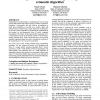Free Online Productivity Tools
i2Speak
i2Symbol
i2OCR
iTex2Img
iWeb2Print
iWeb2Shot
i2Type
iPdf2Split
iPdf2Merge
i2Bopomofo
i2Arabic
i2Style
i2Image
i2PDF
iLatex2Rtf
Sci2ools
GECCO
2006
Springer
2006
Springer
Segmentation of medical images using a genetic algorithm
Segmentation of medical images is challenging due to poor image contrast and artifacts that result in missing or diffuse organ/tissue boundaries. Consequently, this task involves incorporating as much prior information as possible (e.g., texture, shape, and spatial location of organs) into a single framework. In this paper, we present a genetic algorithm for automating the segmentation of the prostate on two-dimensional slices of pelvic computed tomography (CT) images. In this approach the segmenting curve is represented using a level set function, which is evolved using a genetic algorithm (GA). Shape and textural priors derived from manually segmented images are used to constrain the evolution of the segmenting curve over successive generations. We review some of the existing medical image segmentation techniques. We also compare the results of our algorithm with those of a simple texture extraction algorithm (Laws' texture measures) as well as with another GA-based segmentatio...
GA-based Segmentation Tool | GECCO 2006 | Genetic Algorithms | Image Segmentation Techniques | Optimization |
Related Content
| Added | 23 Aug 2010 |
| Updated | 23 Aug 2010 |
| Type | Conference |
| Year | 2006 |
| Where | GECCO |
| Authors | Payel Ghosh, Melanie Mitchell |
Comments (0)

